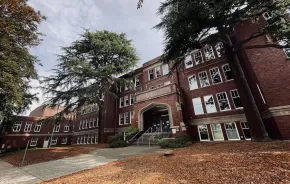
When the pandemic hit this spring, area schools — like most of our institutions — were completely unprepared. While teachers and administrators made a heroic effort to shift almost overnight to a completely different teaching model, in too many cases, the resulting patchwork did more to highlight the inequities in the system than it did to educate the kids. The summer provided a much-needed opportunity for educators and policymakers to step back and evaluate what had worked in the spring in order to develop a strategy for approaching the next school year, when the only certainty would be that things would not be returning to business as usual. For much of the summer, a Magic 8-Ball seemed as good a forecaster as any for education’s future, with its enigmatic answer of “Cannot predict now.”
On July 9, regional education administrators convened for a digital event hosted by the Puget Sound Business Journal to exchange some straight talk about “The Future of Education.” There were two moderated panel discussions. The first session specifically addressed K–12 education and featured a panel composed of Bellevue School District Superintendent Dr. Ivan Duran, Highline Public Schools Superintendent Dr. Susan Enfield and Seattle Public Schools Superintendent Denise Juneau. The second session focused on higher education and featured Seattle Central College President Sheila Edwards Lange, City University of Seattle President Randy Frisch, Seattle University President Stephen Sundborg, S.J., and Cornish College of the Arts President Raymond Tymas-Jones. As the seven educators discussed their plans, some themes emerged.
The only certainty? Continued uncertainty
The first of these themes, of course, was continued uncertainty. “Our plans are constantly evolving,” said Duran. In the few weeks after entering Phase 2 of reopening, an uptick in COVID-19 cases had already raised the specter of renewed restrictions. It was a stark reminder that schools don’t need to plan just for the eventual reopening of buildings; in response to changing infection rates, they also need to develop the flexibility to add, or more likely, reduce the amount of time students spend in the classroom.
The panelists were reluctant to make concrete promises about what to expect. The wisdom of this caution was borne out less than a week later when the Seattle Education Association (Seattle’s teachers’ union) issued a statement opposing in-person teaching in the fall, resisting federal pressure (and the district’s own preliminary plan) to reopen buildings to the extent possible. The following week, Kent, Bellevue and Northshore districts announced they would start the 2020–2021 school year with the remote instruction model until the risk of significant transmission of COVID-19 has decreased enough to resume in-person instruction. Seattle Public Schools followed suit July 22, when Superintendent Juneau released a similar recommendation; the School Board will vote on it and an associated plan on August 12.
At the time of publication, few specifics of the remote-only plan were released, leaving families with little sense of what they can expect on a day-to-day basis in the fall.
What districts can expect is that they will need to continue to respond to changing guidelines as scientific understanding of the virus evolves; negotiations with unions over working conditions continue; and the various opinions and feelings of families and staff about eventually returning to in-person instruction are acknowledged and addressed.
Child care is a huge, huge issue for so many of our families. We need holistic, broad solutions to these issues, and that is one that school systems cannot do alone. mdash; Dr. Susan Enfield
Despite the continuously shifting circumstances, educators are trying to envision a plan that will provide as much safety and continuity for students as possible. This means that although the goal is to have as many kids in school as often as possible as soon as possible, districts and parents must always be prepared to fall back to 100 percent remote learning if and when circumstances require it.
“Child care is a huge, huge issue for so many of our families,” said Enfield. “We need holistic, broad solutions to these issues, and that is one that school systems cannot do alone.” In the absence of ready options, many parents will be scrambling to piece together their own child-care solutions for at least part of every week and potentially for long stretches of the coming school year.
Redefining normal
All three public school district superintendents agree that education will not be returning to normal anytime soon, if ever. The three districts initially developed similar scenarios for the fall semester, because, as Enfield noted, “There really aren’t that many good options for returning to school and abiding by the health and safety guidelines.”
The districts, as well as the colleges and universities represented on the higher-education panel, all expected to start the school year with a hybrid model of distance learning and in-person instruction.
“I think we can all agree that remote learning in the fall will look quite different from how it looked in the spring, because we learned a lot of lessons. I think it will be much higher quality, much more reliable, and I think that’s important to put out there, because the reality is that remote learning, or distance learning, will be a part of the 2020–21 school year for every child,” said Enfield.
In the preliminary reopening plans the districts outlined, the initial proportion of remote learning and in-person days would vary based on several factors, including grade level and the physical capacity of the available classrooms. At such time when reopening plans will be implemented, parents should expect that their kids, no matter what grade they are in, will have at least one day of remote learning every week (and in most cases, more) and will have to wear masks in the classroom on the days they do attend school.
Bellevue Public Schools developed a plan that would maximize in-person classes for pre-K through second grade, with other grades learning remotely for 50 percent of the time. The Highline district was also looking to bring the youngest students into the classroom more frequently if staffing and practical considerations could be met.
But the Seattle district scrapped a similar plan. Juneau explained: “We also had an idea that we would bring back our youngest learners four times a week in person. But we just surveyed our community, and right now — and this could also change — only 8 percent of our families actually want to stay home full-time remotely.” At the time of the discussion, the Seattle district anticipated two days of in-person learning and three days of remote learning as the most likely scenario for all grades.
Alternative plans
However, Seattle’s teachers’ union opposed any in-classroom teaching in the fall, calling it “reckless” under current conditions, and questioned the survey results. Respondents to the survey were overwhelmingly white. Families of color, which are more severely impacted by the pandemic and are twice as likely to feel that it’s unsafe to send their kids to school, were underrepresented in the survey results.
The Seattle Times published a working draft of an alternative proposal that some Seattle district teachers and school board members are developing. That plan, citing both the reduced virus transmission risk in outdoor spaces and the potential learning benefits of outdoor education models, proposes to relocate classrooms to outdoor shelters.
This plan was still in draft form at the time of this article’s publication, and it left a lot of questions about feasibility unanswered. For example, many campuses in Seattle have almost no outdoor space. Moving students from those schools to the outdoors would require some legal and contractual heavy lifting to obtain “classroom” spaces in parks or other open areas.
But the plan certainly represents a creative and innovative approach to holistically rethinking the education system. By allowing students who are most at risk to have more in-person teaching time in a different instructional paradigm and lower-infection risk environment than an enclosed classroom, the alternative plan envisions education as an anti-racist institution, something that all three districts endorse. Seattle’s planning documents for developing a fall education plan identify equity, cultural competence and versatility as guiding values in responding to family choice and special needs. Similarly, Bellevue’s plan identifies using COVID-19 as an opportunity to disrupt inequities as a primary goal. Highline also cites a focus on addressing the inequities made visible during the pandemic as a guiding principle.
Demographic complexity
In addition to considerations regarding age and race for the overall student population, students with special needs will need better solutions than what they received in the spring. Seattle is prioritizing as much in-person learning as possible for students receiving special education services to ensure they are provided instruction in alignment with their Individualized Education Programs (IEPs) and 504 plans. This may include in-person, small group instruction if it is determined that services can be provided safely and services cannot be accessed successfully through remote learning. On the other hand, students with higher health risks — as well as many teachers and staff — may not be able to attend in person at all, when plans to reopen buildings are eventually implemented.
Members of the higher-education panel decried the Trump administration’s policy — since abandoned — that international university students enrolled in online classes could not remain in the country. At the same time, the panelists said they were responding to a demographic shift toward local students, as more students are choosing to apply or transfer to colleges closer to home. Seattle Central College (SCC) President Sheila Edwards Lange said this is on top of the community colleges’ expected increase in local students as Seattle’s Promise program takes effect, with about 500 local high school graduates already expected to enroll at SCC this fall. The impact of the pandemic on Running Start enrollments is still uncertain, as enrollment deadlines have been extended through the summer.
Logistical complexity
“Every time you think of one thing, there are 17 other cascading items that you have to think about. It’s very complex,” said Juneau. Every classroom needs to be reconfigured to allow for 6-foot spacing between everyone. Removing items from classrooms to allow such spacing requires increased storage capacity, not just for those items but for the additional technology, personal protective equipment and cleaning supplies that will have to be stocked going forward.
Those additional supplies and reconfigurations also cost a lot of money — Juneau estimates $15 million in Seattle — during a time when budgets are particularly constrained.
“It’s not only the costs — there’s also loss of revenue from our nutrition program, and in Bellevue, we have a before- and after-school day-care program,” added Duran.
Faculty and staff also need training in both remote-teaching techniques and the health and safety protocols that will be required for in-person classrooms. Administrators will work to reconfigure and expand usable classrooms — possibly even into non-school spaces. But they are also juggling complex staffing models to accommodate faculty and staff who are at higher risk for infection and may not be able to safely work in person. And all of these necessary changes to working conditions involve union negotiations.
Back to basics
At the same time, “There has been a new focus on basic needs,” said Duran. By “basics,” he is not referring to the three R’s.
“The schools are the social safety net for the community,” said Juneau, whose district had already served 1 million meals to students and their families during the pandemic by early July.
“There were equity issues that we already knew about and didn’t fight hard enough for,” Enfield noted. Her district is now providing meals seven days a week, even during the summer break, to families and students who, she says, often have no other food in the house.
While some people might question whether it’s appropriate for educators to shoulder these responsibilities, the health and safety of students are prerequisites to learning. It is harder for a child to learn when they are hungry and frightened.
“In addition to physical precautions, we have to make sure we’re supporting mental health and social and emotional learning,” said Juneau. When students eventually return to the classroom, time will be used differently than it was in the past, with priorities focused on small-group instruction, mentorship for students of color who are furthest from receiving educational justice, and social-emotional support and other wraparound services.
Economic recovery relies on the child care that schools provide for working parents.
For distance learning, the equity issues are even more directly related to academics.
Whether it’s limited bandwidth in rural areas or limited family resources that preclude the purchase of laptops and internet service, “Children in America in 2020 are being denied education because they don’t have home internet access,” said Enfield. All three superintendents on the panel agreed that a patchwork approach to providing access, involving strategies such as distributing hot spots, was insufficient. Enfield, in particular, advocated for internet service to be a public utility, like water and electricity.
Optimism
Despite the uncertainties and challenges, all the educators on both panels were optimistic about the future of education. Although governments historically have considered schools as places to cut spending when budgets are tight — and the pandemic has blown a $4.5 billion hole in the state’s current budget — educators are ready to fight for funding.
“If they [the state Legislature] need to find savings, it should not be on the back of public education,” said Juneau. “We are a critical component of reopening the economy. If we aren’t in session and aren’t able to do the things we need to do, there is very little [likelihood] that business will also thrive.” Economic recovery relies on the child care that schools provide for working parents.
The panelists see the current disruption as an opportunity for systemic changes. As the status quo of standardized testing and rigid protocols have had to be abandoned, the educators are hopeful that new solutions will address not only the question of internet access, but other inequities in education. Many teachers are receiving additional training in social-emotional support factors and remote-education techniques.
Seattle University President Stephen Sundborg pointed out that this training will improve teaching in the future, even when there is a return to the classroom, commenting wryly, “We’ll never have to worry about snow days again.”











